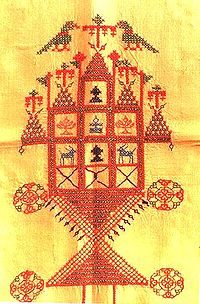
Kasuti
Encyclopedia

Karnataka
Karnataka , the land of the Kannadigas, is a state in South West India. It was created on 1 November 1956, with the passing of the States Reorganisation Act and this day is annually celebrated as Karnataka Rajyotsava...
, India
India
India , officially the Republic of India , is a country in South Asia. It is the seventh-largest country by geographical area, the second-most populous country with over 1.2 billion people, and the most populous democracy in the world...
. Kasuti work which is very intricate sometimes involves putting up to 5,000 stitches by hand and is traditionally made on dresswear like Ilkal
Ilkal saree
Ilkal saree is a traditional form of saree which is a common feminine wear in India. Ilkal saree takes its name from the town of Ilkal in the Bagalkot district of Karnataka state, India. Ilkal sarees are woven using cotton warp on the body and art silk warp for border and art silk warp for pallav...
and Kanchivaram sarees. The Karnataka
Karnataka
Karnataka , the land of the Kannadigas, is a state in South West India. It was created on 1 November 1956, with the passing of the States Reorganisation Act and this day is annually celebrated as Karnataka Rajyotsava...
Handicrafts Development Corporation (KHDC) holds a Geographical Indications (GI) protection for Kasuti embroidery which provides Intellectual Property
Intellectual property
Intellectual property is a term referring to a number of distinct types of creations of the mind for which a set of exclusive rights are recognized—and the corresponding fields of law...
rights on Kasuti to KHDC.
History
The history of Kasuti dates back to the Chalukya period. The name Kasuti is derived from the words Kai (meaning hand) and Suti (meaning cotton), indicating an activity that is done using cotton and hands. The women courtiers in the Mysore Kingdom in the 17th century were expected to be adept in 64 arts, with Kasuti being one of them. It is also said that the Lambani clan left their traditional home of RajasthanRajasthan
Rājasthān the land of Rajasthanis, , is the largest state of the Republic of India by area. It is located in the northwest of India. It encompasses most of the area of the large, inhospitable Great Indian Desert , which has an edge paralleling the Sutlej-Indus river valley along its border with...
and settled down in Karnataka
Karnataka
Karnataka , the land of the Kannadigas, is a state in South West India. It was created on 1 November 1956, with the passing of the States Reorganisation Act and this day is annually celebrated as Karnataka Rajyotsava...
and brought the Kasuti craft along with them. Sarees
Sari
A sari or sareeThe name of the garment in various regional languages include: , , , , , , , , , , , , , is a strip of unstitched cloth, worn by females, ranging from four to nine metres in length that is draped over the body in various styles. It is popular in India, Bangladesh, Nepal,...
embroidered with Kasuti were expected to be a part of the bridal trousseau of which one saree made of black silk with Kasuti embroidery called Chandrakali saree was of premier importance.
Kasuti work
Kasuti work involves embroidering very intricate patterns like gopura, chariotChariot
The chariot is a type of horse carriage used in both peace and war as the chief vehicle of many ancient peoples. Ox carts, proto-chariots, were built by the Proto-Indo-Europeans and also built in Mesopotamia as early as 3000 BC. The original horse chariot was a fast, light, open, two wheeled...
, palanquin, lamps and conch shells. Locally available materials are used for Kasuti. The pattern to be embroidered is first marked with charcoal or pencil and then proper needles and thread are selected. The work is laborious and involves counting of each thread on the cloth. The patterns are stitched without using knots to ensure that both sides of the cloth look alike. Different varieties of stitches are employed to obtain the desired pattern. Some of the stitches employed are Ganti, Murgi, Neyge and Menthe. Ganti is a double running stitch used for marking vertical, horizontal and diagonal lines, Murgi is a zig-zag stitch, Neyge is a running stitch and Menthe is a cross stitch resembling fenugreek seeds.
Current scenario
Kasuti work has grown beyond its traditional boundaries to be used in other dress materials like the Mysore silk saree. A Lambani Kasuti centre was set up in Hubli by the Department of Social Welfare, Government of KarnatakaKarnataka
Karnataka , the land of the Kannadigas, is a state in South West India. It was created on 1 November 1956, with the passing of the States Reorganisation Act and this day is annually celebrated as Karnataka Rajyotsava...
to encourage the Kasuti culture and also provide a single roof for the Lambani women to showcase their craft. However Kasuti work is suffering from poor patronage with not many people willing to take the craft seriously; an indication of which is the closure of the Karnataka Kasuti classes by the JSS college in Dharwad
Dharwad
Dharwad, also known as Dharwar, is a city and a DISTRICT PLACE in India's Karnataka state.Dharwad is the administrative seat of the Dharwad District. The municipality of Hubli-Dharwad covers an area of 200.23 km²...
.

